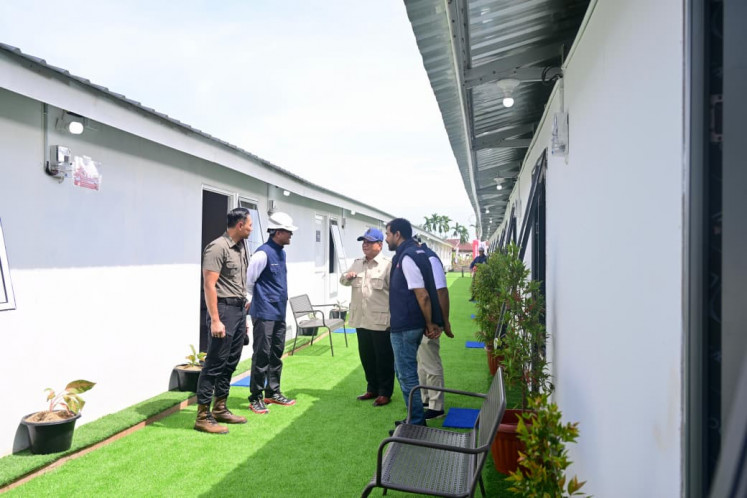Popular Reads
Top Results
Can't find what you're looking for?
View all search resultsPopular Reads
Top Results
Can't find what you're looking for?
View all search resultsVirus outbreak at crossroads? Impact on ASEAN
Now, Southeast Asian economies may face new downgrades associated with the outbreak’s likely economic impact.
Change text size
Gift Premium Articles
to Anyone
W
ith the new coronavirus — the 2019 novel coronavirus acute respiratory disease (2019-nCoV ARD) — there are now (2 p.m. Wuhan time, Tuesday) more than 42,600 confirmed cases worldwide. If the current pace prevails, that figure will exceed 50,000 in the coming days.
And yet, there may be something else going on behind the reported figures.
On the one hand, the number of confirmed cases outside China is less than 500, and there have been only two deaths, which both are associated with the virus epicenter Wuhan. While these numbers are likely to increase in the near future, the low starting-point suggests that China’s costly and draconian measures may have saved many lives within and particularly outside China.
More importantly, the pace of the contagion may be decelerating in China. In international media, the spotlight is mainly on the absolute numbers of accumulated cases and deaths, which are likely to increase. And yet, the relative increase of these accumulated cases has decreased ever since mid-January. Even more importantly, the relative daily increase of new cases, which have critical impact on the longer-term duration and severity of the outbreak, may be amid a crossroads.
The confirmed new cases increased steadily from mid-January soaring to almost 3,900 on Feb. 4. Since then, the numbers have fallen below 2,700. In relative terms, the change has been almost progressive, having plunged from almost 350 percent to negative.
The big question is, will the trend prevail. While the data could indicate a possible turnaround in the virus outbreak, there is no assurance that the deceleration will prevail. It is well known that virus trend lines can zigzag. Consequently, complacency in the struggle against the outbreak is no option.
Also, all projections rely on data accuracy and presume the absence of adverse mutations within and outside China. Furthermore, the trend lines are predicated on the idea that there will be no new, major outbreaks as people in China are now returning to their homes after the holiday period.
Finally, the trend is predicated on the idea that containment will succeed outside China, where precautions have been lagging in many countries, including high-income nations.
Since mid-2018, ASEAN countries have suffered collateral damage associated with the United States-Sino trade friction, slowing world trade and eroding global growth. Even before the outbreak, regional growth prospects were downgraded by 0.3 to 0.4 percentage points for 2019 to 2020. Now, Southeast Asian economies may face new downgrades associated with the outbreak’s likely economic impact.
Last December, the Asian Development Bank (ADB) revised its forecast down to 4.4 percent for 2019 but maintained at 4.7 percent for 2020. The latter was predicated on the anticipated mild recovery in China and the US. It will be downgraded.
Prior to the virus outbreak, growth forecasts were downgraded for Singapore and Thailand, but upgraded for Brunei and Vietnam, with the remaining ASEAN economies on track to meet forecasts, despite export declines and weaker investment weighing on growth prospects.
In early 2020, downgrades are likely to deepen in Singapore and Thailand, while positive prospects in Vietnam will not prevail. Growth forecasts in Taiwan and East Asia — South Korea and Taiwan — will be penalized, due to anticipated supply chain disruptions, particularly in electronics, machinery and textiles.
Growth prospects in Singapore have eroded significantly and will be compounded by the outbreak. The 2020 real gross domestic product forecast could be downgraded to less than 1 percent. In Hong Kong, political volatility coupled with the outbreak will extend the technical recession into the first quarter.
The rest of Southeast Asia — Malaysia, Indonesia, Lao, Cambodia, Myanmar and the Philippines — will find it hard to stay on track with forecasts. In the past year, softening domestic investment exacerbated export woes in larger economies — Indonesia, Malaysia, Philippines, Singapore and Thailand — but domestic consumption held up to cushion the slowdown.
Since household spending is the first victim of the virus outbreak, larger economies will not be immune to it. But in each case, the specific country impact will depend on the duration and severity of the virus spread.
***
Strategist of the multipolar world and founder of Difference Group. The original commentary was released by The Manila News on Monday.











